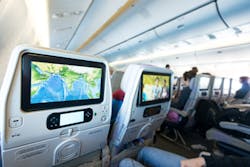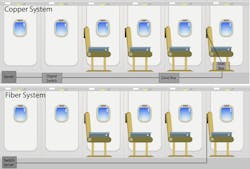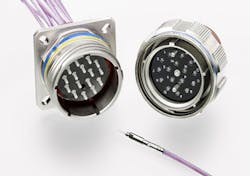The Case for Fiber in Commercial Aircraft: Solving the Bandwidth/Distance Challenge
The Case for Fiber in Commercial Aircraft: Solving the Bandwidth/Distance Challenge
Earle Olson
Business Development Manager, Aerospace, Defense & Marine
TE Connectivity
Commercial aircraft run on information. As aircraft designers embrace MEA (more electric aircraft) to replace mechanical control systems, embedded computers are evolving to increasing signal processing and control loads. From increasingly sophisticated radar to the sensors and actuators controlling the flight systems, almost nothing happens without electronics. Passenger amenities—principally in-flight entertainment and Internet access—also benefit by providing the capabilities for high-definition video, high-speed on-line connectivity, and a host of value-added services.
High-definition video and games on demand are being met by fiber-optic systems (Source: TE Connectivity)
The Need for High Speeds
The ability to pack evermore processing power into smaller packages also allowed distributed avionics that puts the processing power closer to the point of use rather than in a centralized avionics bay. It also creates the need for communication between the distributed boxes.
High processing loads means faster embedded computers and faster interconnections between boxes, actuators and sensors. While protocols like IEEE 1394 and USB are finding application, Ethernet has emerged as the de facto favorite, with 1 Gb/s today and 10 Gb/s soon being required to carry the load.
The Need for SWaP
Aircraft designers are always looking to reduce SWaP—size, weight, and power consumption—to create better fuel efficiency and lower operating costs. Smaller connectors having lightweight composite shells to replace heavier metal shells are complemented by cables and harnessing components that are likewise smaller and lighter. Designers are also evaluating composite enclosures as a replacement for aluminum ones—thereby achieving up to 40 percent weight savings. Smaller and lighter, must also be “built to survive” the environmental, vibration and other hazards common in aircraft.
Speed versus Distance: The Benefits of Fiber Optics
High bandwidth / matched impedance copper cables on aircraft have co-existed with fiber applications for decades. For many applications, designers are finding fiber optics makes better sense technically and economically. For copper cables, higher the data rate mean shorter transmission distance. And as the electronic density increases the attention that must be paid to signal integrity, shielding may be required as an EMC (electromagnetic compatibility) measure. Shielding increases cable size and weight.
An optical cable has three main benefits:
- Smaller size and weight. While fiber-to-copper comparisons depend on specific cable configurations, consider “generic” baseline cables: a duplex fiber-optic cable offers approximately 25 percent space savings and 50 percent weight savings over a shielded PVC Cat 5e cable.
- EMI immunity. Since optical fibers are inherently immune to electrical noise—neither receiving nor radiating energy—they can be applied without undue concern about EMI control. The potential need to shield copper cables only drives up size and weight.
- Longer transmission distances. While many interconnect distances in aircraft are relatively short, passenger cabins in commercial aircraft can present end-to-end challenges for copper cable.
Fiber optics also helps increase the longevity of the physical layer of the aircraft’s network, allowing new services to be introduced that require higher data rates. Designers don’t have to worry that a new service will obsolete the cabling infrastructure, or, put another way, that the existing infrastructure won’t allow the new service.
Cabin Systems Make a Perfect Fiber Fit
To illustrate the pro-fiber argument, consider the video system in a passenger aircraft. Airlines are moving from a few overhead screens, serving multiple passengers to seatback screens serving each passenger. This move also allows revenue-enhancing on-demand services tailored to each passenger—choice of movies and broadcast television, music with flexible playlists, games, or shopping.
The figure below compares both a traditional copper and a fiber-to-the-screen system. Fiber-optic cable can be run directly from the server to the screen. This “home run architecture” eliminates the intermediate switches, zone boxes, and seat electronics required with a copper system. Weight savings per seat are about 60% over legacy copper systems. Beyond the reduction in complexity, a fiber-optic system can have bandwidth to spare. Multimode fibers can easily carry data rates of >10 Gb/s across the length of even the largest wide-body aircraft.
Fiber optics simplifies IFE by providing higher bandwidth and longer transmission distances than copper cable (Source: TE Connectivity)
One example of this approach is the Lumexis FTTS (Fiber-To-The-Screen) system, which will be offerable soon on the 737-800, 787-900, and 787 MAX aircraft. The system uses 50/125 optical fibers homerun to each seat-back screen. Typically, there are production-break interconnections at the side walls or floor--one at the server end and one at the seat end—to make installation and maintenance easier. These production breaks, for example, allow cables from the server to sidewall and from side wall to screen to be standardized. The longer cables in the side wall or underfloor will vary in length, depending on distance from server to seat.
Because fiber-optic inserts are available for most industry-standard aviation connectors, designers have a wide range of options. Ceramic ferrule physical-contact termini are the most common, with connector options including ARINC, EN4165, and MIL-DTL-38999 Series III styles. TE Connectivity recently introduced the MC801 connector, which combines industry-standard ARINC 801 termini and a 38999-style shell. The choice of connector depends in part on the degree of modularity desired. A high-fiber-count connector simplifies connectivity, but limits modularity. Where repeated mating/unmating at the side wall or low leg interface, a termini with a protected expanded-beam interface provides high-mating-cycle durability and easy cleaning. ARINC 845, which covers expanded beam technologies, recently selected TE’s PRO BEAM EB16 terminus for such applications. The terminus fits size 16 cavities in industry-standard connector inserts.
MC801 connectors (Source: TE Connectivity)
Fiber or Copper? Both Have a Place
The question often arises: when is fiber going to make copper obsolete? Fact is, it isn’t. The two will coexist for the foreseeable future, each being employed where it makes the most sense. Each brings specific advantages, from the comfortable familiarity of copper to the high-bandwidth capabilities of fiber over longer distances. As systems are challenged to offer users a seamless experience in handling data, video, and other bandwidth-hungry processes, both optical and copper connectivity must ensure that the end-to-end solution can accommodate production breaks in the path. While both technologies continue to evolve and give designers new options in meeting ever-increasing data loads, fiber is finding wider use as its benefits of weight savings, high bandwidth, and longer transmission distances become ever more important.
Earle Olson is business development manager in TE Connectivity's Aerospace, Defense & Marine division.
TE’s new MC801 connector combines the high performance of ARINC 801 optical termini with the convenience of a familiar D38999 Series III connector style. Read More.
Learn more about TE’s rugged fiber optic products




